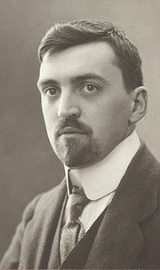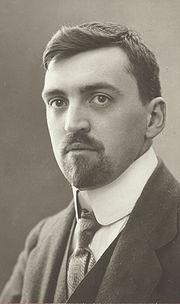
Hector Hodler
Encyclopedia

) was a Swiss Esperantist
Esperantist
An Esperantist is a person who speaks or uses Esperanto. Etymologically, an Esperantist is someone who hopes...
who had a strong influence on the early Esperanto movement.
Hodler was a son of the Swiss painter Ferdinand Hodler
Ferdinand Hodler
Ferdinand Hodler was one of the best-known Swiss painters of the 19th century.-Life:Hodler was born in Berne, the eldest of six children. His father, Jean Hodler, made a meager living as a carpenter; his mother, Marguerite , was from a peasant family...
, who after a period of poverty became suddenly very well-to-do. As a 16-year-old, Hector Hodler learned Esperanto with his classmate Edmond Privat
Edmond Privat
Edmond Privat was a Francophone Swiss Esperantist. A historian, university professor, author, journalist and peace activist, he was a graduate of the University of Geneva and a lecturer for the World Peace Foundation...
, and founded soon afterward a club and the journal Juna Esperantisto ("The Young Esperantist"). The schoolbench was their editorial office for five years as they managed production, addressed copies and replied to correspondence. Sometime later they learned about Idiom Neutral
Idiom Neutral
Idiom Neutral is an international auxiliary language, published in 1902 by the International Academy of the Universal Language under the leadership of Waldemar Rosenberger, a St...
and about Bolak
Bolak (Blue Language)
Bolak is a constructed language that was invented by Léon Bollack. The name of the language means both `blue language' and `ingenious creation' in the language itself.-History:...
, in order to convince themselves as to whether Esperanto was truly the "best" international language. Besides The Young Esperantist, he authored articles in Through the World and the translation of the novel Paul et Virginie
Paul et Virginie
Paul et Virginie is a novel by Jacques-Henri Bernardin de Saint-Pierre, first published in 1787. The novel's title characters are very good friends since birth who fall in love...
(Paul and Virginia) by Bernardin de Saint Pierre (1905).
In 1906, on the occasion of the second World Congress of Esperanto
World Congress of Esperanto
The World Congress of Esperanto has the longest tradition among international Esperanto conventions, with an almost unbroken run of more than a hundred years. The congresses have been held since 1905 every year, except during World Wars I and II...
, he saw in the organizational proposals by Théophile Rousseau and Alphonse Carles for Esperanto consuls (konsuloj) a chance to realize his plan to organize reciprocal self-help among people of good will. This was the germ of the World Esperanto Association
World Esperanto Association
The World Esperanto Association is the largest international organization of Esperanto speakers, with members in 121 countries and in official relations with the United Nations and UNESCO. In addition to individual members, 70 national Esperanto organizations are affiliated to UEA...
(in Esperanto, UEA: Universala Esperanto-Asocio) of which Hodler was a co-founder.

Monato
Monato is a monthly magazine produced in Esperanto which carries articles on politics, culture and economics. It is printed in Belgium and distributed to readers in 65 countries. The title simply means "month"....
. He edited it for 13 years until his death, except for six months in 1914 during the First World War. It is still produced as a publication associated with the UEA. He authored and translated many important articles, and he suggested translating masterpieces instead of trivial things. He signed his articles with the initials A. R.
The proposals of Rousseau and Carles were melded with his plans, were discussed in his magazine and received a warm welcome. By the third World Esperanto Congress in 1907, there were already about 200 consuls (delegates). Hodler and others such as Théophile Rousseau founded the World Esperanto Association
World Esperanto Association
The World Esperanto Association is the largest international organization of Esperanto speakers, with members in 121 countries and in official relations with the United Nations and UNESCO. In addition to individual members, 70 national Esperanto organizations are affiliated to UEA...
on April 28, 1908, and Hodler became General Director and Vice-President. He was a friend and colleague of Eduard Stettler, and Edmond Privat
Edmond Privat
Edmond Privat was a Francophone Swiss Esperantist. A historian, university professor, author, journalist and peace activist, he was a graduate of the University of Geneva and a lecturer for the World Peace Foundation...
was one of his editors. Hodler wanted to use the magazine "to create a strong bond of solidarity among members of diverse languages." During the war, Hodler, with the then secretary of the association Hans Jakob
Hans Jakob
Hans Jakob was a German football player. He was born in Munich.He played over 1000 games as goalkeeper for SSV Jahn Regensburg, and also for FC Bayern Munich from 1942 to 1945...
, organized the Wartime Assistance of the association.
After the death of Harold Bolingbroke Mudie
Harold Bolingbroke Mudie
Harold Bolingbroke Mudie was a British esperantist. He served as the first President of the World Esperanto Association.He learnt Esperanto in 1902, having read about it on the Review of Reviews...
in 1916, the presidency of the World Esperanto Association was vacant until after the war, when Hodler was elected to succeed him.
Hodler was especially interested in social questions, pacifism and animal protection. Privat wrote about him: "To that which the genius of Zamenhof
L. L. Zamenhof
Ludwig Lazarus Zamenhof December 15, 1859 – April 14, 1917) was the inventor of Esperanto, the most successful constructed language designed for international communication.-Cultural background:...
initiated in the linguistic field, he added the necessary basis in the social field." According to an article by László Halka in Enciklopedio de Esperanto, "it is characteristic of his noble spirit and humanity that in Geneva he joined the local animal protection society, and that he said he would like to make the UEA an association to protect humans." In the last several years of his life, when he was already quite unhealthy, he turned mainly to scientific problems. In 1916 he wrote a 387-page work in French about the peaceful organization of peoples.
After his death in 1920, he bequeathed to the UEA the magazine Esperanto and his Esperanto library
Esperanto library
The following Esperanto libraries and collections of works in the Esperanto language are worthy of note:*The Montagu Butler Library of Esperanto materials, maintained by the Esperanto Association of Britain. This holds some 12,500 books as well as a documentary archive, a photo archive,...
, which nowadays bears his name
Hector Hodler Library
The Hector Hodler Library is one of the largest Esperanto libraries, with approximately 30,000 books, with periodicals, manuscripts, photos, music, and other collections. It occupies three rooms in the central office of the Universal Esperanto Association in Rotterdam, Netherlands.Other major...
, as well as a large sum of money to ensure its continued existence.

